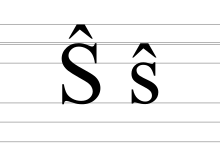Ŝ: Difference between revisions
mNo edit summary |
No edit summary Tags: Reverted Mobile edit Mobile web edit |
||
| Line 4: | Line 4: | ||
{{Esperanto sidebar |expanded=Language}} |
{{Esperanto sidebar |expanded=Language}} |
||
'''Ŝ''' or '''ŝ''' (S [[circumflex]]) is a [[consonant]] in [[Esperanto orthography]], representing the sound {{IPAblink|ʃ}}. |
'''Ŝ''' or '''ŝ''' (S [[circumflex]]) is a [[consonant]] in [[Esperanto orthography]], representing the sound {{IPAblink|ʃ}}. |
||
[[File:Latin_letter_S_with_circumflex.svg|thumb|Latin letter S with circumflex]] |
|||
Esperanto orthography uses a [[diacritic]] for all four of its postalveolar consonants, as do most Latin-based [[Slavic languages|Slavic]] alphabets ([[Polish alphabet|Polish]] is the most notable exception). Letters and [[Digraph (orthography)|digraph]]s that are similar to ''ŝ'' (also based on ''[[s]]'') and represent the same sound include [[Czech alphabet|Czech]], [[Latvian alphabet|Latvian]], [[Lithuanian alphabet|Lithuanian]], [[Slovak alphabet|Slovak]], [[Slovene alphabet|Slovene]], [[Serbian Latin]], and [[Croatian alphabet|Croatian]] ''[[š]]'', [[Albanian alphabet|Albanian]] and [[English_alphabet|English]] ''sh'', [[German alphabet|German]] ''sch'', [[Polish alphabet|Polish]] ''sz'', [[Azerbaijani alphabet|Azerbaijani]], [[Turkish alphabet|Turkish]] and [[Turkmen alphabet|Turkmen]] ''[[ş]]'', [[Romanian alphabet|Romanian]] ''[[ș]]'', [[Hungarian alphabet|Hungarian]] ''s'', [[French alphabet|French]] ''ch'', and [[Portuguese alphabet|Portuguese]] ''x'' and ''ch''. The [[Cyrillic]] letter [[ш]] represents the same sound. |
Esperanto orthography uses a [[diacritic]] for all four of its postalveolar consonants, as do most Latin-based [[Slavic languages|Slavic]] alphabets ([[Polish alphabet|Polish]] is the most notable exception). Letters and [[Digraph (orthography)|digraph]]s that are similar to ''ŝ'' (also based on ''[[s]]'') and represent the same sound include [[Czech alphabet|Czech]], [[Latvian alphabet|Latvian]], [[Lithuanian alphabet|Lithuanian]], [[Slovak alphabet|Slovak]], [[Slovene alphabet|Slovene]], [[Serbian Latin]], and [[Croatian alphabet|Croatian]] ''[[š]]'', [[Albanian alphabet|Albanian]] and [[English_alphabet|English]] ''sh'', [[German alphabet|German]] ''sch'', [[Polish alphabet|Polish]] ''sz'', [[Azerbaijani alphabet|Azerbaijani]], [[Turkish alphabet|Turkish]] and [[Turkmen alphabet|Turkmen]] ''[[ş]]'', [[Romanian alphabet|Romanian]] ''[[ș]]'', [[Hungarian alphabet|Hungarian]] ''s'', [[French alphabet|French]] ''ch'', and [[Portuguese alphabet|Portuguese]] ''x'' and ''ch''. The [[Cyrillic]] letter [[ш]] represents the same sound. |
||
Revision as of 08:33, 13 October 2023
| Part of a series on |
Ŝ or ŝ (S circumflex) is a consonant in Esperanto orthography, representing the sound [ʃ].

Esperanto orthography uses a diacritic for all four of its postalveolar consonants, as do most Latin-based Slavic alphabets (Polish is the most notable exception). Letters and digraphs that are similar to ŝ (also based on s) and represent the same sound include Czech, Latvian, Lithuanian, Slovak, Slovene, Serbian Latin, and Croatian š, Albanian and English sh, German sch, Polish sz, Azerbaijani, Turkish and Turkmen ş, Romanian ș, Hungarian s, French ch, and Portuguese x and ch. The Cyrillic letter ш represents the same sound.
Ŝ is used in ISO 9:1995 (standard of transliteration into Latin characters of Cyrillic characters) for letter Щ.
Ŝ is the twenty-third letter in Esperanto orthography. Although it is written as sx and sh respectively in the x-system and h-system workarounds, it is normally written as S with a circumflex: ŝ.

